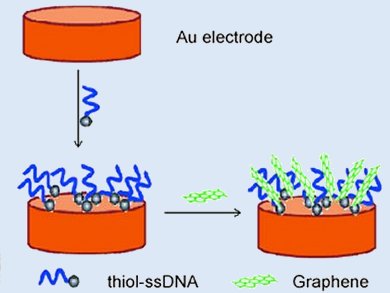Graphene has become widely used in the field of analytical electrochemistry. This is because a graphene-modified interface can provide a large electrochemically active area and leads to high detection sensitivity.
As a result of a collaborative study between researchers at the Chinese Academy of Sciences and King Abdulaziz University, Jeddah, Saudi Arabia, Xuping Sun and his team have fabricated a graphene-on-gold electrode that can be used for detecting dopamine (DA). The approach exploits interactions between graphene and DNA bases using thiolated single-stranded DNA as a linker and π-π stacking interactions (see figure). Because graphene can absorb the carbon-based rings of DA in a stable manner and retain the excellent conductivity of the gold electrode, the sensor exhibits high sensitivity and selectivity in the presence of ascorbic acid and has a detection limit for DA of 0.8 nm.
This is a new approach for using graphene-on-gold substrates as sensors where the electrode fabrication process is complete within 30 minutes.
Image: © Wiley-VCH
- Single-Stranded DNA-Mediated Immobilization of Graphene on a Gold Electrode for Sensitive and Selective Determination of Dopamine,
L. Wang, X. Qin, S. Liu, Y. Luo, A. M. Asiri, A. O. Al-Youbi, X. Sun,
ChemPlusChem 2011.
DOI: 10.1002/cplu.201100009




